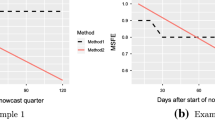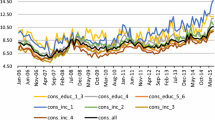Abstract
We analyse forecasts of professional forecasters for Germany regarding the time span from 1970 to 2004. This novel panel data set renders it possible to assess the accuracy and efficiency of growth and inflation forecasts more efficiently than in previous studies. We argue that the forecasts are, on average, unbiased and weakly—but not strongly—efficient. Using model confidence sets suggested by Hansen et al. (2004), we find that, besides the effect of diverging forecasting dates, no other substantial differences in forecasting quality among forecasters exist. Nevertheless, on the basis of a direction-of-change analysis we argue that it is not always advisable to listen to the majority of forecasters.


Similar content being viewed by others
Notes
This is also the reason why some institutions appear twice in our data set, while others do not. In some other cases (e.g. the Kiel institute), the forecasting frequency has also changed over time from twice a year to four times a year.
This choice is motivated by the “headline figure” of the statistical office for the respective year. Note, however, that the forecasts frequently refer to “growth” rather than explicitly to either GDP or GNP or to one figure only. In such cases, we have assumed that the forecasters made no distinction between the concepts and had the same forecast for both figures.
The data used in this study may be downloaded from http://www.ulrich-fritsche.net.
Unless otherwise stated, our notation follows the textbook of Diebold (1998).
The exogenous variables were standardised to avoid biases in the estimation of the constant.
Note that we treat the inflation rate as a stationary variable. We base this judgement on a standard test for unit roots, which are not presented in the paper, but available upon request from the authors.
We are grateful to Peter Reinhard Hansen and Asgar Lunde, who helped to calculate the respective MCS and p-values.
Again, the result for the IWH has to be interpreted with caution since we only have 12 exploitable observations.
References
Artis MJ (1987). How accurate are the IMF’s short term forecasts? Another examination of the world economic outlook. Staff Studies for the World Economic Outlook. Washington, District of Columbia: 1–36
Artis MJ, Marcellino M (2001) Fiscal forecasting: the track record of the IMF, OECD and EC. Econometrics Journal 4:20–36
Büttner T, Horn GA (1993) Wie gut sind Prognosen? Eine Überprüfung der Vorhersagen der Gemeinschaftsdiagnose und des DIW am Beispiel des BSP. DIW Diskussionspapier Nr. 73. Berlin
Christofferson PF, Diebold FX (1996) Further results on forecasting and model selection under asymmetric loss. Journal of Applied Econometrics 11:561–571
Dicke H, Glissmann HG (2002) Konjunkturprognosen und wissenschaftlich-technischer Fortschritt. Wirtschaftsdienst 82:167–169
Diebold FX (1998) Elements of Forecasting. Cincinnati
Diebold FX, Lopez J (1996) Forecast evaluation and combination. In: Maddalla GS, Rao CR (eds.) Handbooks of statistics 241–268
Döpke J, Langfeldt E (1995) Zur Qualität von Konjunkturprognosen für Westdeutschland 1976–1994. Kieler Diskussionsbeitrag Nr. 274. Kiel
Döpke J (2000) Haben Konjunkturprognosen einen politischen Bias? Schmollers Jahrbuch-Zeitschrift für Wirtschafts-und Sozialwissenschaften 120:587–620
Elliot G, Kommunjer I, Timmermann A (2004) Biases in macroeconomic forecasts: irrationality or asymmetric loss? http://repec.org/esNASM04/up.6440.1075609439.pdf
Hansen PR, Lunde A, Nason JM (2004) Model confidence sets for forecasting models. http://ssrn.com/abstract=522382
Heilemann U (1998) Zu den Projektionen des Jahreswirtschaftsberichts der Bundesregierung. In: Heilemann U, Kath D, Kloten N (Hrsg.) Entgrenzung als Erkenntnis-und Gestaltungsaufgabe: Festschrift für Reimut Jochimsen zum 65 Geburtstag: 79–100 Berlin
Heilemann U (2004) Besser geht es nicht-Genauigkeitsgrenzen von Konjunkturprognosen. Jahrbücher für Nationalökonomie und Statistik. Forthcoming
Heilemann U, Stekler HO (2003) Has the accuracy of German macroeconomic forecasts improved? Discussion Paper of the German Research Council’s research centre 475. 31/03
Hinze J (1996) Konjunkturprognosen unter veränderten Rahmenbedingungen: Auswirkungen der deutschen und europäischen Einigung. Hamburger Jahrbuch für Wirtschafts-und Gesellschaftspolitik 41:59–84
Holden K, Peel DA (1990) On testing for unbiasedness and efficiency of forecasts. The Manchester School 58:120–127
Keane MP, Runkle DE (1990) Testing the rationality of price forecasts: new evidence from panel data. American Economic Review 80:714–735
Kirchgässner G (1984) Sind die Erwartungen der Wirtschaftssubjekte rational? Eine empirische Untersuchung für die Bundesrepublik Deutschland. Weltwirtschaftliches Archiv 120:279–300
Kirchgässner G, Savioz M (2001) Monetary policy and forecasts for real GDP growth: an empirical investigation for the Federal Republic of Germany. German Economic Review 2:339–365
Kirchgässner G, Müller UK (2003) Are forecasters reluctant to revise their predictions? Mimeo, Swiss Institute of International Economics and Applied Economics analysis
Neumann MJM, Buscher HS (1980) Die Inflationsprognosen der Arbeitsgemeinschaft wirtschaftswissenschaftlicher Forschungsinstitute: sind sie rational? Weltwirtschaftliches Archiv 116:533–550
Newey W, West K (1987) A simple positive semi-definite, heteroskedasticity and autocorrelation consistent covariance matrix. Econometrica 55:703–708
Nierhaus W (1998) Ifo-Konjunkturprognosen und Wirklichkeit-eine Ergebnisanalyse für die Bundesrepublik im Zeitraum 1991–1997. ifo-Wirtschaftskonjunktur 50:1–11
Stege C (1989) Zur Beurteilung der Prognosetätigkeit der "führenden Wirtschaftswissenschaftlichen Forschungsinstitute" in der Bundesrepublik Deutschland. Hamburg
Tichy G (1994) Konjunktur. Stilisierte Fakten, Theorie, Prognose. Berlin
Weidmann J (2002) Hat sich die Prognosequalität des Sachverständigenrates systematisch verschlechtert? Wirtschaftsdienst 82:741–747
Zarnowitz V (1999) Has the business cycle been abolished? NBER Working Paper No. 6367. Cambridge MA
Acknowledgements
The authors wish to thank two anonymous referees as well as Imke Brüggemann, Andreas Cors, Roland Döhrn, Felix Hüffner, Hans-Martin Krolzig, Thomas Knetsch, Udo Ludwig, Francis Piotrowski, Jürgen Wolters, Rudolf Zwiener and seminar participants at the Institute for Statistics and Econometrics at the Free University Berlin for their helpful comments on an earlier draft of this paper. We also wish to thank Birger Antholz, Hamburg, for pointing us to errors in our data and for providing us with additional data. We are particularly grateful to Peter Reinhard Hansen and Asgar Lunde, who used their procedures to calculate the relevant MCS and p-values for us. The usual disclaimer applies. The views presented in this paper are the authors’, and do not necessarily reflect those of the DIW Berlin or the Deutsche Bundesbank.
Author information
Authors and Affiliations
Corresponding author
Appendix
Appendix
Institutions and forecasts under investigation
Institution | Source of forecast | Start/ending dates of forecasts | Average month until end of forecast horizon | Additional notes |
|---|---|---|---|---|
Council of Economic Advisors | Sachverständigenrat, annual reports, several years, Wiesbaden | 1970–2004 | 13 | |
Joint forecast of the six (formerly five) “leading” German economic research institutes, autumn forecast | Arbeitsgemeinschaft wirtschaftswissenschaftlicher Forschungsinstitute, various issues, Berlin | 1970–2004 | 14 | |
Joint forecast of the six (formerly five) “leading” German economic research institutes, autumn forecast | Arbeitsgemeinschaft wirtschaftswissenschaftlicher Forschungsinstitute, various issues, Berlin | 1970–2004 | 8 | |
German Institute of Economic Research (DIW Berlin) | German Institute of Economic Research (ed), Economic Bulletin, various issues, Berlin | 1970–2004 | 11 | Two forecasts per year; we refer to the one in January only |
Kiel Institute for World Economics (IfW) | “Die Weltwirtschaft”, various issues, Kiel | 1970–2004 | 12 | No forecasts for 1975 and 1976 (see Stege (1989)) for a discussion of possible reasons). We use numbers from the joint forecast for these years, since the Kiel Institute was part of the joint forecast. For forecasts, we use the December forecast. |
HWWA Institute of Economic Research, Hamburg | “Wirtschaftsdienst”, various issues, Hamburg | 1970–2004 | 12 | Two forecasts per year, we refer to the autumn forecast. |
Ifo Institute, Munich | “ifo Schnelldienst”, various issues | 1970–2004 | 12 | |
Institute for Economic Research Halle (IWH) | “Wirtschaft im Wandel”, various issues, Halle/Saale | 1993–2004 | 11 | Institute founded in 1992 |
Rhine-Westphalia Institute for Economic Research (RWI), Essen | Institute’s “Economic report” | 1970–2004 | 11 | |
OECD | Economic Outlook, various issues, Paris | 1970–2004 | 13 | Two forecasts, we use the autumn forecast. |
IMF, spring forecast | World Economic Outlook, various issues, Washington | 1974–2004 | 9 | Some forecasts have not been published. Here we use the data collected by Artis (1987). |
IMF, autumn forecast | World Economic Outlook, various issues, Washington | 1974–2004 | 15 | Some forecasts have not been published. In this cases we use the data collected by Artis (1987). |
European Commission, spring forecast | European Economy, various issues, Brussels | 1974–2004 | 9 | |
European Commission, autumn forecast | European Economy, various issues, Brussels | 1974–2004 | 14 | |
Trade Union Institute (WSI) | WSI Mitteilungen, various issues, Düsseldorf | 1974–2004 | 12 | In 2001 no growth forecast and in 2001 and 2002 no inflation forecasts. |
Institute of the German Economy (IW) | IW-Trends; various issues, Cologne | 1970–2004 | 13 | |
Economic report of the German federal government | Jahreswirtschaftsbericht, various issues, Bonn/Berlin | 1970–2004 | 10 |
Rights and permissions
About this article
Cite this article
Döpke, J., Fritsche, U. Growth and inflation forecasts for Germany a panel-based assessment of accuracy and efficiency. Empirical Economics 31, 777–798 (2006). https://doi.org/10.1007/s00181-005-0050-5
Received:
Accepted:
Published:
Issue Date:
DOI: https://doi.org/10.1007/s00181-005-0050-5




